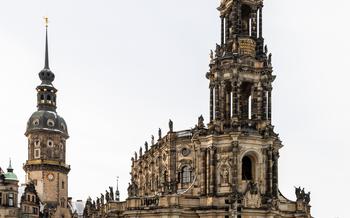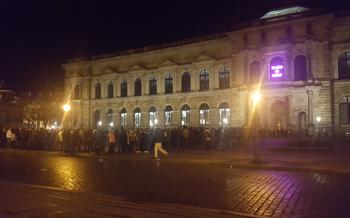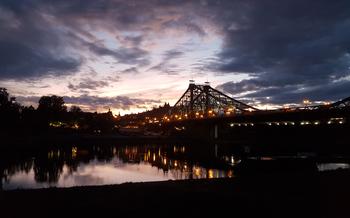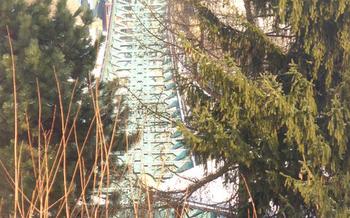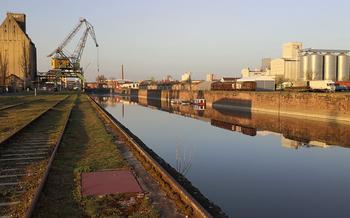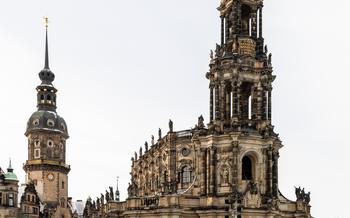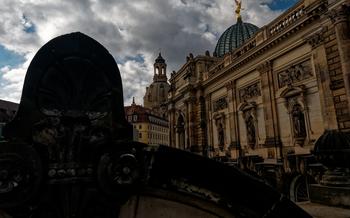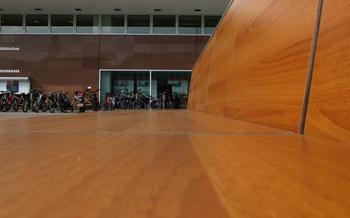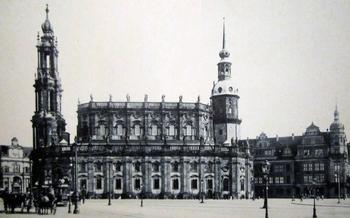
The Sound of Bronzes (Klang der Bronzen)
- A Symbol of Dresden's Resilience
- Exploring the Church's Architecture
- Witnessing the Impressive Interior
- Ascending the Dome for Panoramic Views
- Attending a Classical Concert
- Observing the Changing Seasons
- Exploring the Surroundings
- Paying Respects to the Victims of War
- Joining a Guided Tour
- Learning about the Church's History
- Attending a Church Service
- The Frauenkirche Museum: A Journey Through History
- Participating in Events and Festivals
- Capturing the Essence through Photography
- Insider Tip: Experience the Frauenkirche's Acoustical Marvels
A Symbol of Dresden's Resilience
The Frauenkirche, or Church of Our Lady, stands as a testament to Dresden's indomitable spirit, rising from the ashes of World War II to once again grace the city's skyline. In 1945, the church was reduced to a pile of rubble, a victim of the Allied firebombing that decimated much of Dresden. Yet, the people of Dresden refused to let their beloved church be forgotten. In a remarkable feat of engineering and perseverance, the Frauenkirche was painstakingly reconstructed, stone by stone, over a period of nearly 13 years. Its completion in 2005 marked a pivotal moment in Dresden's history, symbolizing the city's resilience, reconciliation, and unwavering faith.
Today, the Frauenkirche stands as a beacon of hope and renewal, a symbol of Dresden's ability to overcome adversity and rebuild. It is not just a religious edifice but a cultural landmark and a source of inspiration for people worldwide. Its majestic dome, visible from afar, serves as a reminder of the strength of the human spirit and the power of community to heal and rebuild.
Exploring the Church's Architecture
The Frauenkirche stands as a testament to the enduring power of Baroque and Renaissance architecture, showcasing a harmonious blend of both styles. Its striking dome, a symbol of Dresden's skyline, is an architectural marvel, towering over the city at 91 meters. The dome's unique design features a lantern adorned with intricate carvings, adding an extra touch of grandeur to its already impressive silhouette.
Beyond its dome, the Frauenkirche's exterior boasts a wealth of architectural details that invite closer examination. The sandstone facade is adorned with elaborate sculptures, each telling a story from the Bible or the history of Dresden. The intricate carvings on the portals and windows showcase the exceptional craftsmanship of the church's builders.
The interior of the Frauenkirche is no less impressive, with its vast, light-filled space and soaring arches creating a sense of awe and wonder. The altar, made of Meissen porcelain, is a masterpiece of Baroque art, featuring intricate floral motifs and delicate figurines. The church's organ, with its 6,000 pipes, is one of the largest in Germany, filling the space with rich, resonant music.
The Frauenkirche's architecture is not merely an aesthetic marvel; it also holds profound symbolic meaning. The dome, representing heaven, rises above the earthly realm, while the octagonal shape of the church symbolizes the eternal covenant between God and humanity. Every element of the church's design contributes to its overall message of hope, resilience, and faith.
Witnessing the Impressive Interior
The Frauenkirche's interior is as awe-inspiring as its exterior. The nave, with its soaring columns and delicate arches, creates a sense of grandeur and reverence. The altar, a masterpiece of Baroque craftsmanship, is adorned with intricate carvings and a radiant golden glow. The organ, with its 30,000 pipes, is one of the largest and most renowned in the world, filling the church with its majestic sounds.
Artwork, sculptures, and stained-glass windows adorn the church's interior, each telling a story from the Bible or the history of Dresden. The stained-glass windows, depicting scenes from the life of Jesus, cast a kaleidoscope of colors onto the marble floor, creating a breathtaking spectacle.
The restoration of the church's interior was a painstaking process, involving meticulous attention to detail and the use of traditional techniques. The result is a faithful recreation of the original splendor, a testament to the skill and dedication of the craftsmen and artisans involved.
When visiting the Frauenkirche, it is important to remember that it is an active place of worship. Visitors are expected to be respectful of the church's sanctity and to observe proper etiquette. Silence is requested during services, and photography is not permitted.
A visit to the Frauenkirche's interior is an unforgettable experience, offering a glimpse into the rich history, artistry, and spirituality of this iconic landmark.
Ascending the Dome for Panoramic Views
The Frauenkirche's dome, a magnificent architectural feat, offers breathtaking panoramic views of Dresden and the Elbe River. Standing atop the dome, visitors are rewarded with a bird's-eye perspective of the city's iconic landmarks, including the Zwinger Palace, the Semperoper, and the Elbe bridges. The vistas extend beyond the city center, encompassing the rolling hills of Saxony and the distant spires of neighboring towns.
During World War II, the dome served as a critical vantage point for air raid spotters, who would climb the stairs to monitor the approaching enemy aircraft. Today, visitors can retrace their steps, ascending the 273 stairs to the viewing platform, a physically demanding but ultimately rewarding experience. The climb is well worth the effort, as the panoramic views from the dome are simply stunning.
For the best views, aim to visit the dome on a clear day, preferably around sunrise or sunset when the golden light casts a warm glow on the city. Whether you're a photography enthusiast capturing the cityscape or a traveler seeking a unique perspective, the Frauenkirche's dome offers an unforgettable experience.
Attending a Classical Concert
The Frauenkirche's acoustics are world-renowned, making it an ideal venue for classical music concerts. The church's soaring dome and spacious interior create a rich and resonant sound that envelops listeners. Regular performances include organ recitals, choral concerts, and chamber music ensembles.
To book tickets, visit the Frauenkirche's website or purchase them at the church's box office. Ticket prices vary depending on the concert and seating category, but generally range from €15 to €30.
When choosing a concert, consider your musical preferences and the type of experience you're seeking. Organ recitals showcase the church's magnificent Silbermann organ, while choral concerts often feature works by renowned composers such as Bach, Handel, and Mozart. Chamber music concerts offer a more intimate setting, with smaller ensembles performing works from the Baroque to the contemporary periods.
Attending a concert at the Frauenkirche is a truly unforgettable experience. The combination of exquisite music, stunning architecture, and the church's unique atmosphere creates a magical and transcendent moment.
Personal Anecdote:
I attended an organ recital at the Frauenkirche on a crisp autumn evening. As the organist's fingers danced across the keys, the church filled with the majestic sound of the Silbermann organ. The music reverberated through the dome, enveloping me in a wave of awe and emotion. It was a truly transcendent experience that left me feeling uplifted and inspired.
Observing the Changing Seasons
The Frauenkirche's beauty transcends seasons, each offering a unique charm. Spring awakens the city with vibrant colors, as the Neumarkt square bursts into bloom. The church's exterior, adorned with intricate carvings, stands amidst a sea of pastel hues, creating a picturesque scene. Summer brings alive the surrounding parks, where locals and tourists alike bask in the sun's warmth. The church's majestic dome glistens against the clear blue sky, inviting visitors to ascend for breathtaking panoramic views.
Autumn transforms Dresden into a canvas of warm colors. The leaves of the surrounding trees turn into shades of gold, orange, and red, creating a stunning backdrop for the Frauenkirche. The church's sandstone facade seems to glow in the soft autumn light, casting a warm and inviting aura. As winter approaches, the city takes on a magical charm. Snowflakes gently fall, covering the church's dome and surroundings in a blanket of white. The church's illuminated windows cast a warm glow against the snowy landscape, creating a truly enchanting sight.
Throughout the year, the Frauenkirche's appearance transforms, offering visitors a different perspective each time. Whether it's the vibrant colors of spring, the sunny skies of summer, the golden hues of autumn, or the snowy wonderland of winter, the church never fails to captivate and inspire. Dress appropriately for the weather to fully embrace the beauty of each season.
Exploring the Surroundings
The Frauenkirche stands as a majestic centerpiece within Dresden's vibrant cityscape, surrounded by notable landmarks and attractions that invite further exploration. A short stroll from the church, the Zwinger Palace captivates visitors with its exquisite Baroque architecture and houses world-renowned art collections, including the Gemäldegalerie Alte Meister (Old Masters Picture Gallery).
Immerse yourself in the lively ambiance of the historic Neumarkt square, located just steps from the Frauenkirche. This charming square boasts a colorful array of shops, cafes, and restaurants, offering a delightful respite amidst your sightseeing adventures. Savor a traditional German meal at one of the square's many eateries, or indulge in a sweet treat at a cozy café while soaking in the vibrant atmosphere.
For those seeking unique finds and local treasures, venture into the charming streets surrounding the Frauenkirche. Discover hidden gems tucked away in quaint boutiques, artisan workshops, and specialty stores. Whether you're searching for handmade souvenirs, exquisite jewelry, or vintage clothing, you're sure to find something special to cherish your visit to Dresden.
As you explore the surroundings of the Frauenkirche, keep an eye out for hidden gems and lesser-known attractions that may not be on the typical tourist trail. Engage with locals, ask for recommendations, and let your curiosity guide you to uncover the hidden treasures that await in this vibrant city.
Paying Respects to the Victims of War
The Frauenkirche stands as a powerful reminder of the devastation wrought by war and the resilience of the human spirit. During World War II, Dresden was subjected to a relentless bombing campaign that culminated in the destruction of much of the city, including the Frauenkirche. The church's ruins remained untouched for decades, serving as a stark testament to the horrors of war.
In the years following the war, the decision was made to reconstruct the Frauenkirche as a symbol of reconciliation and peace. The reconstruction process was meticulously carried out, using original plans and materials whenever possible. The new Frauenkirche was completed in 2005, and it now stands as a symbol of Dresden's resilience and its commitment to preserving its cultural heritage.
Visitors to the Frauenkirche can pay their respects to the victims of war by visiting the crypt, which contains the remains of those who perished in the bombing. The crypt is a somber and moving space that offers a glimpse into the human toll of war. It is a place to reflect on the past and to pray for peace.
The Frauenkirche also hosts regular events and exhibitions that commemorate the victims of war and promote peace. These events provide an opportunity to learn more about the history of the church and its significance as a symbol of reconciliation.
Joining a Guided Tour
Enrich your visit to the Frauenkirche by joining a guided tour led by knowledgeable experts. These tours offer an immersive and comprehensive experience, providing insights into the church's history, architecture, and significance.
Benefits of Guided Tours:
-
Insider Knowledge: Guides share fascinating stories, historical anecdotes, and little-known facts that bring the church to life.
-
Different Types of Tours: Choose from standard tours that cover the basics to in-depth tours that delve into specific aspects of the church's history and architecture.
-
Choice for Your Interests: Whether you're interested in art, history, or religion, there's a tour tailored to your preferences.
-
Budget-Friendly Options: Guided tours are reasonably priced, making them accessible to visitors of all budgets.
Choosing the Right Tour:
-
Consider Your Interests: Select a tour that aligns with your interests, whether it's the church's construction, wartime history, or religious significance.
-
Check Tour Length: Tours vary in duration, so choose one that fits your schedule and attention span.
-
Book in Advance: Popular tours sell out quickly, so reserve your spot well in advance, especially during peak tourist season.
Memorable Tour Experiences:
-
Engaging Storytelling: Guides have a knack for weaving captivating narratives that make history come alive.
-
Personalized Attention: Small group tours allow for personalized interactions and the opportunity to ask questions.
-
Unforgettable Moments: From climbing the dome to exploring hidden corners, guided tours create lasting memories.
Learning about the Church's History
The Frauenkirche's story is a captivating one, marked by destruction, resilience, and rebirth. Its history is deeply intertwined with the history of Dresden itself. Learn about the church's construction in the 18th century under the patronage of August the Strong, the Elector of Saxony. Discover how the church became a symbol of the city's wealth and power.
Delve into the tragic events of World War II, when the Frauenkirche was reduced to ruins during the devastating Allied bombings. Witness the remarkable efforts of the people of Dresden to rebuild their beloved church, a project that took decades to complete. Explore the challenges they faced, the controversies they navigated, and the triumphs they achieved.
Uncover the stories of key historical figures associated with the Frauenkirche, such as George Bähr, the architect who designed the original church, and Ludwig Güttler, the architect who oversaw its reconstruction. Learn about the church's role in shaping Dresden's cultural and religious identity, and its significance as a symbol of reconciliation and peace.
To delve deeper into the Frauenkirche's history, consider reading books such as "The Frauenkirche: A Symbol of Dresden" by Eberhard Burger, or watching documentaries such as "The Frauenkirche: Dresden's Phoenix." Explore online resources such as the Frauenkirche Foundation website, which offers a wealth of information, including historical photographs, videos, and interactive exhibits.
Attending a Church Service
The Frauenkirche is not just a historical and architectural marvel but also a vibrant spiritual community. Attending a church service at the Frauenkirche is a unique and profound experience that allows visitors to connect with the church's spiritual essence and the local congregation.
Different types of services are offered throughout the week, including regular Sunday services, special holiday services, and even concerts and musical performances. Each service is conducted in German, but visitors can follow along with English translations provided on screens or in booklets.
When attending a service at the Frauenkirche, it is essential to be respectful of the sacredness of the space and the religious traditions being observed. Visitors are expected to dress appropriately and maintain a quiet and reverent demeanor during the service.
The Frauenkirche's services are open to people of all faiths and backgrounds. Whether you are a devout Christian seeking spiritual nourishment or a curious traveler interested in experiencing the church's vibrant community, attending a service is a meaningful and enriching way to connect with the Frauenkirche on a deeper level.
The Frauenkirche Museum: A Journey Through History
Nestled within the heart of the Frauenkirche, the church museum invites visitors on a captivating journey through time. Here, the rich history of this iconic landmark unfolds through a treasure trove of artifacts, interactive displays, and multimedia presentations.
As you step into the museum, you'll be greeted by an array of exhibits that showcase the church's construction, destruction, and remarkable reconstruction. Original plans, models, and fragments of the original structure transport you back to the time when the Frauenkirche first graced Dresden's skyline.
Through interactive displays, you'll learn about the painstaking efforts involved in the church's reconstruction. Witness the challenges faced by architects, engineers, and artisans as they meticulously pieced together the Frauenkirche, using traditional techniques and materials.
The museum also pays tribute to the resilience of the Dresden community, whose unwavering determination played a pivotal role in the church's rebirth. Personal accounts, photographs, and videos bring to life the stories of those who dedicated their lives to rebuilding this symbol of hope and reconciliation.
A visit to the Frauenkirche Museum is an immersive experience that deepens your understanding of this extraordinary landmark. It's a place where history comes alive, and the spirit of Dresden's indomitable spirit shines through.
Participating in Events and Festivals
Throughout the year, the Frauenkirche and its surroundings come alive with a variety of events and festivals that celebrate Dresden's rich heritage. Attend the annual Dresden Music Festival, which showcases world-renowned musicians performing classical and contemporary masterpieces within the church's hallowed walls. Don't miss the vibrant Christmas Market, where you can browse festive stalls, indulge in culinary delights, and soak up the magical atmosphere. The church also hosts regular organ recitals, choral concerts, and special services during religious holidays, offering visitors a chance to experience its spiritual and musical grandeur. To make the most of your visit, check the church's website or local event calendars for upcoming events and plan your trip accordingly. These events provide a unique opportunity to immerse yourself in Dresden's vibrant cultural scene and create lasting memories against the backdrop of this iconic landmark.
Capturing the Essence through Photography
The Frauenkirche, with its majestic dome and intricate Baroque details, is a photographer's dream. Whether bathed in the warm glow of dawn or illuminated against the night sky, the church offers endless opportunities for stunning photographs.
For the best exterior shots, consider arriving early in the morning when the light is soft and golden. Position yourself across the square to capture the church's full grandeur, or find a unique angle from one of the surrounding bridges. To capture the church's scale, include people or objects in your foreground.
To photograph the interior, purchase a photo permit at the entrance. The church's lofty dome and intricate details are best captured with a wide-angle lens. Use a tripod to stabilize your camera and shoot at a low ISO to minimize noise.
Remember to be respectful of other visitors and avoid using flash photography during services or concerts. Share your photos on social media using #Frauenkirche to inspire others to visit this architectural masterpiece.
Insider Tip: Experience the Frauenkirche's Acoustical Marvels
Beyond its visual splendor, the Frauenkirche boasts exceptional acoustics, renowned among musicians and music lovers alike. To fully appreciate this auditory masterpiece, plan your visit to coincide with one of the regular organ recitals or choral concerts held within its hallowed walls. The church's unique architectural features, including its domed ceiling and reverberant surfaces, create an immersive soundscape that transports listeners to another realm. Whether you're a classical music aficionado or simply seeking a transcendent auditory experience, attending a concert at the Frauenkirche is an unforgettable opportunity to witness the harmonious interplay of music and architecture.
